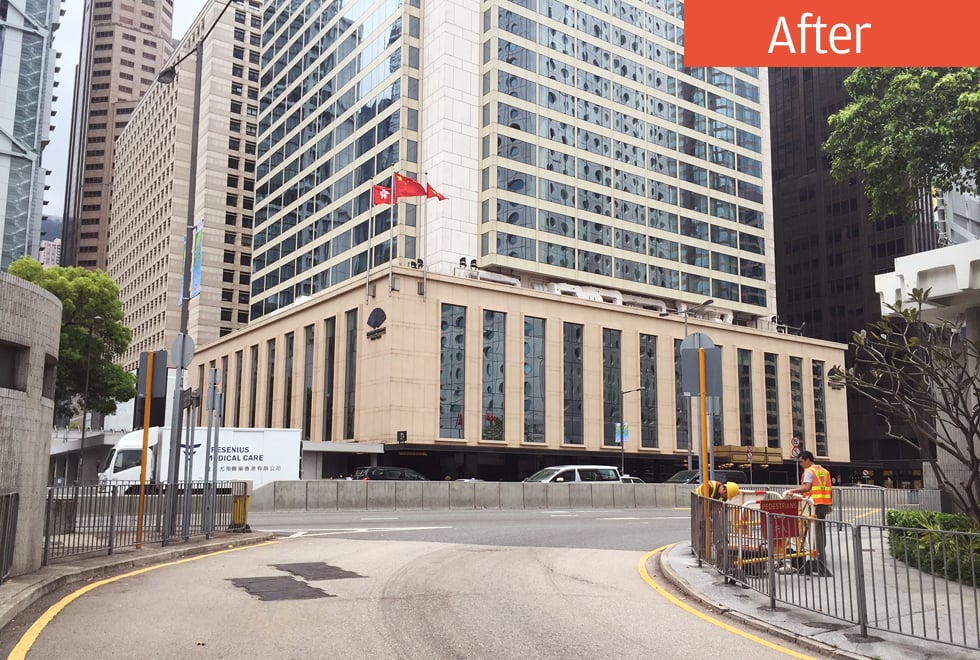



Move the slider on the above image to view the differences over time.
Hong Kong's Victoria Harbour has undergone a massive facelift through the decades - a phenomenon captured in stunning before-and-after photos currently on display in an exhibition.
The trove of old photographs, on show at the "Images of Our City: Landmarks and Coastlines of Central" exhibit at the University of Hong Kong (HKU), show the gradual narrowing of the city's harbour through massive reclamation projects.
The dramatic reshaping of the landscape is shown by juxtaposing archive stills with newer snapshots - taken decades or nearly a century later in 2015 - from roughly the same vantage points.
The exhibit touches particularly on reclaiming land from the sea, or constructing roads or blocks of buildings on hectares of space where water once stood. It also reflects Hong Kong's struggle for space.


In one photo, the Queen's Building is pictured circa 1910 standing proudly on the waterfront, with little boats seen docked on the quay in front of it. But in a photo taken in 2015, mirroring the camera angle as closely as possible, one now gazes at the facade of the Mandarin Oriental Hotel, flanked by skyscrapers.
Another set shows Connaught Road in the 1950s, with a wide expanse of road overlooking the sea, and boats docked just metres away from the colonial buildings' doorsteps.
This is compared to a snap from modern-day Connaught, where a cluster of towers and cramped roads now stand, with the waterfront having disappeared from view.
Other photos show Queen's Road and Des Voeux Road in the late 19th century and Edinburgh Place in the 1950s.


The archive photos and old postcards were mostly "donated" by various individuals to Jacky Yu, a Hong Kong educator who set up a Facebook page, meant to be an online museum, in 2012 called "Old Hong Kong Photo".
"I have been interested in history since I was young," said Yu, who majored in Chinese at Shue Yan University and earned his master's degree at Peking University. "I started collecting old photographs in 2007. This is because I find that conventional history books present the subject in a boring way.
"Also, photos record facts in some sense and they have aesthetic value. I decided to set up the Facebook page in 2012 as way to back up my collection and to share it to the public."


Some of the photos were purchased by Yu himself. He collects only "special" photos - ones that are not widely available on the internet. Among Yu's favourites is a unique snap of Statue Square in the 1950s, around the time when its eponymous statue "had already been sent to Japan during the occupation to be melted for weapons".
Though this was returned to Hong Kong - albeit in Victoria Park - Yu said the photo explains why there is no statue in Statue Square.
Yu collected more than 2,000 photos, which he later thought could be worth showing to the public through a touring exhibition. He put out a call last year for volunteers to help with the project.


Last year, they got invited by Chinese University's Chung Chi College to hold an exhibit. Then the show moved to HKU with the help of its Faculty of Arts.
"Rather than displaying old photos solely for reminiscing the past", says HKU's Jodie Cheng, the student coordinator for the photo exhibition, the show also wanted to give the public a fresh view of the issue of reclamation.
"The exhibition wishes to [send a message] that we should strike a balance between development and reclamation," she said.


"In Hong Kong, the history of urban development is inseparable from that of reclamation. The government has used ... reclamation to solve problems in housing, transport or financial development," the third-year history major said.
Students from HKU, the Chinese University of Hong Kong, City University and Polytechnic University also helped bring the exhibition plans to life.
Jacky Yu also collaborated with the Hong Kong Global Network, which aims to promote the city's history to the public through social media, books and other means.
Yu says it is important for Hong Kong citizens to pay attention to the problems posed by relentless reclamation, and for the government to think carefully about balancing development with preserving heritage sites.


"In fact, there is an ordinance that prevents reclamation in Victoria Harbour. Yet, after going through some legal procedures, the government continues to carry out reclamation projects. The characteristics of Hong Kong are being obliterated," he said.
Cheng said there had been an enthusiastic response to the exhibition, with some Hongkongers saying the photos "reminded them of the good old days".
"Hopefully we can understand our identity better through studying history. History may be able to offer a new perspective to the current social issues," Cheng said.
Yu, meanwhile, said they were planning to publish a book on Kowloon's coastline as well as developing a mobile app that would help bring these fascinating glimpses of Hong Kong's past ever closer to the public's reach.

